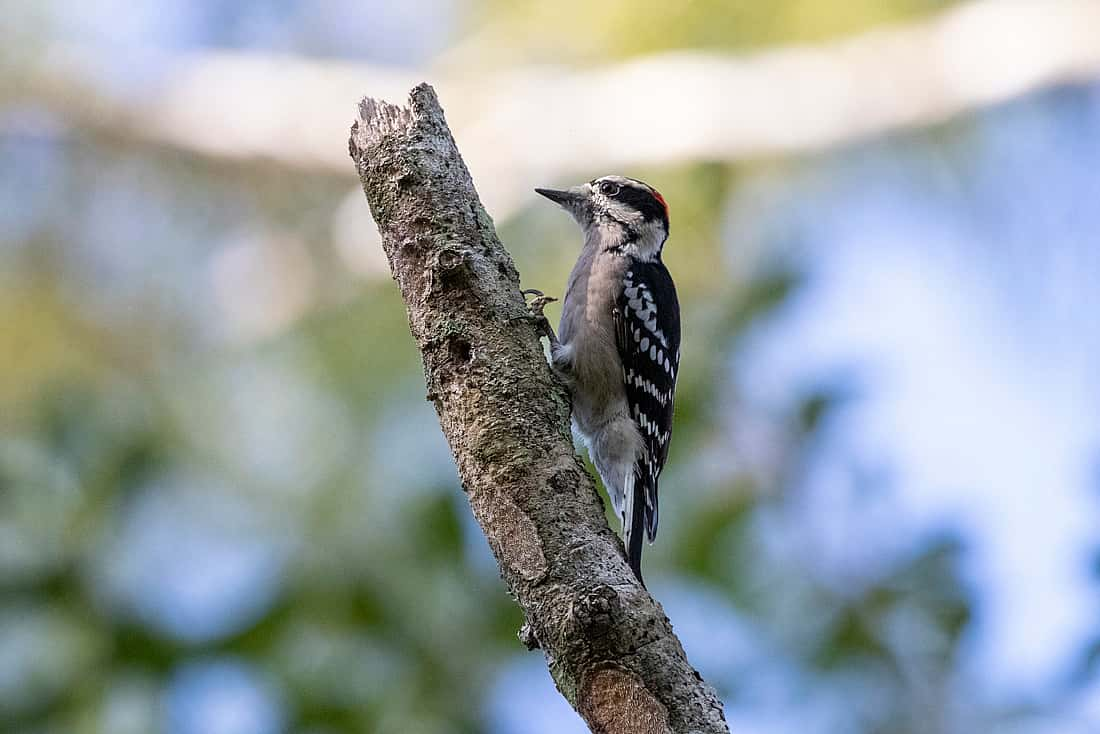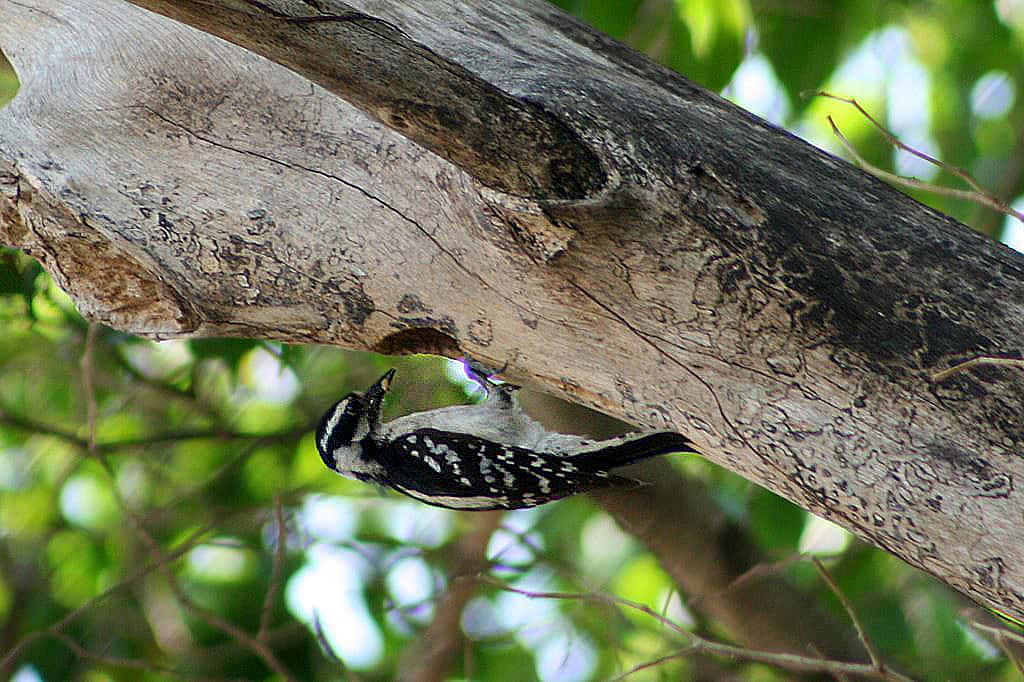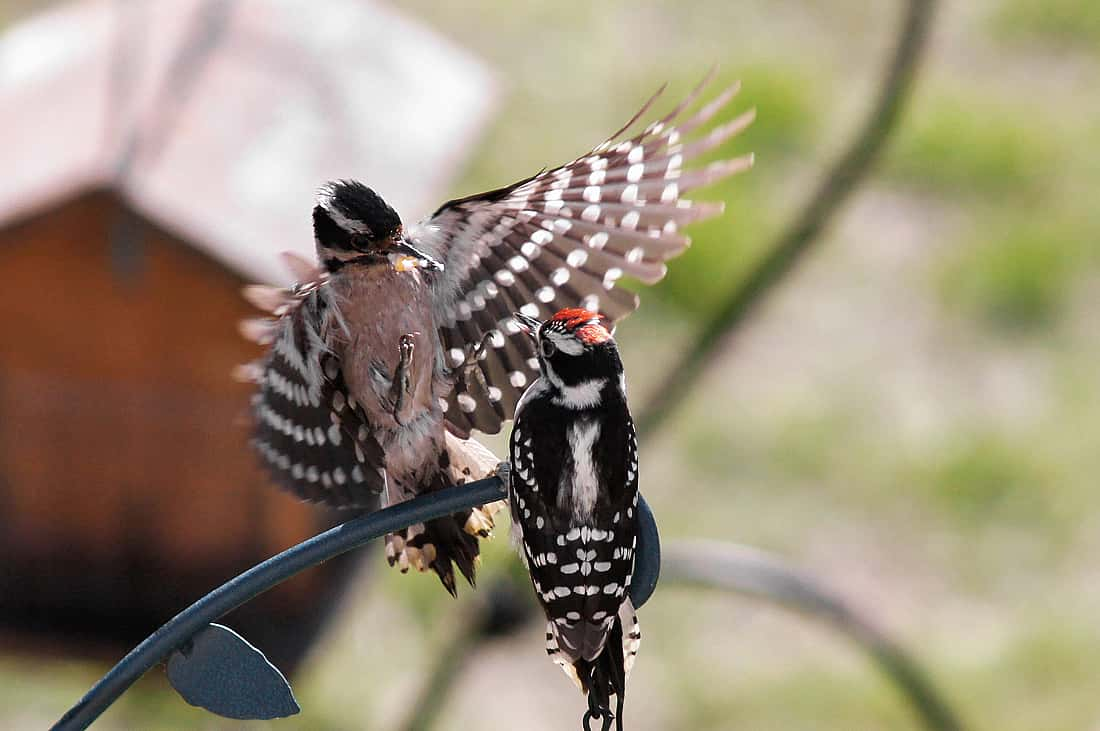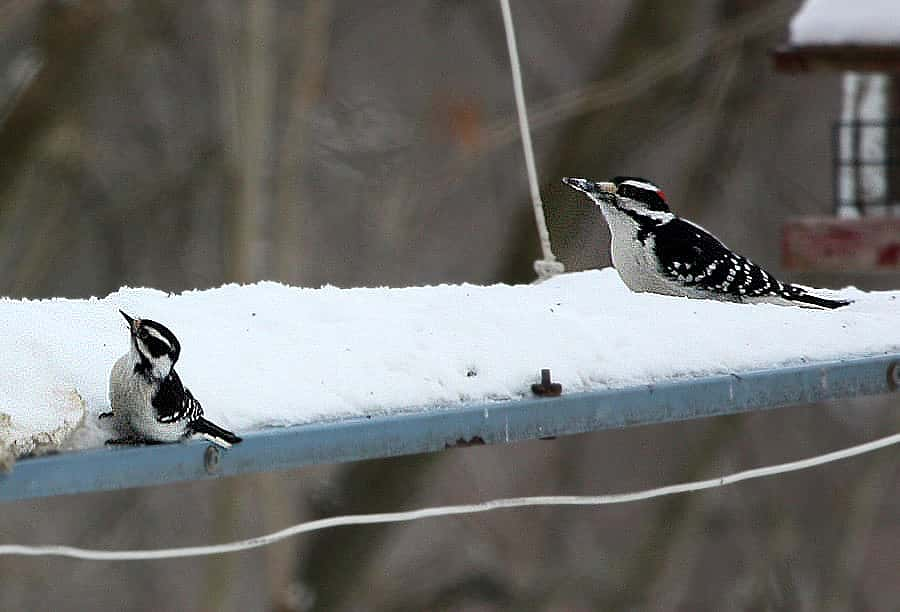
Downy Woodpeckers: Small Drummers
Downy Woodpeckers (Dryobates pubescens) are only one of 239 species of woodpeckers worldwide. They are also the smallest woodpecker in all of North America. Although it does not like the arid Southwest, it can be found almost everywhere else including parts of Alaska, across Canada, and the lower 48 states.

A small, active bird, it moves rapidly over tree trunks and branches. Downy Woodpeckers are able to move horizontally upward and downward and will do this more often than most other woodpeckers. Furthermore, Downys lean their stiff tail feathers against trees for support. You may also observe them hanging upside down while searching for insects. In addition, they also move along stems of grasses and wildflowers.
Downy Woodpeckers will frequent backyard feeders, parks, and woodlands. It can also live in open areas, feeding among tall weeds and grasses.
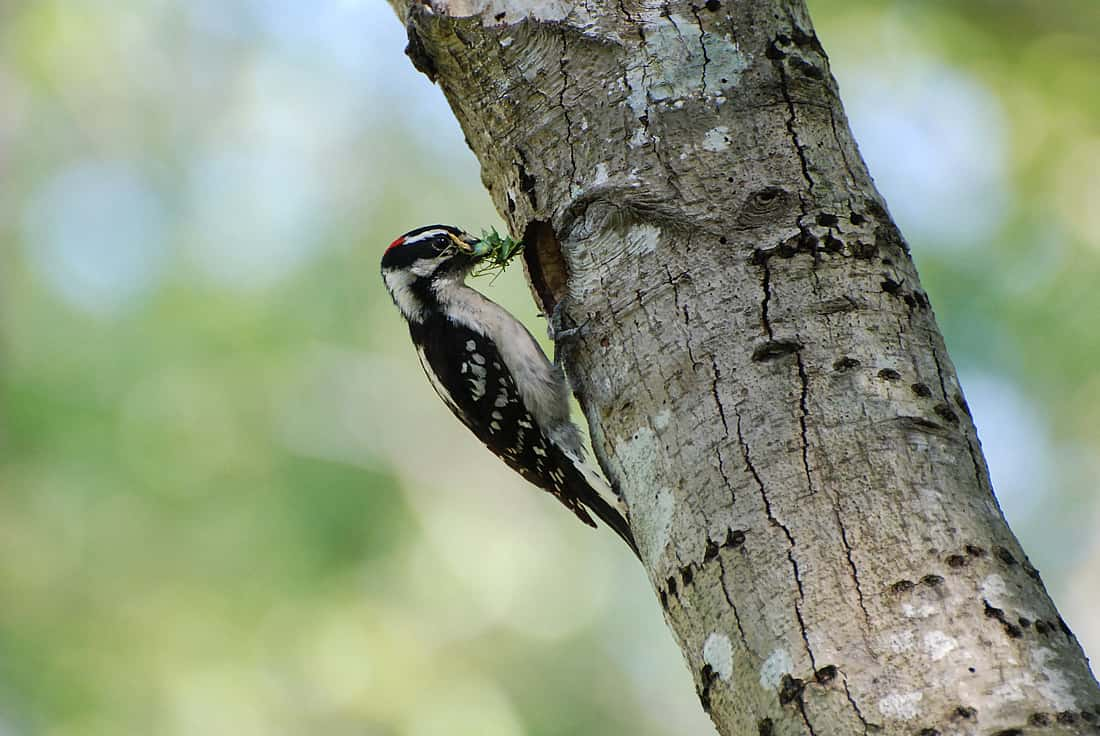
Diet
More than 75 percent of a Downy Woodpecker’s diet are insects. This may include grasshoppers, ants, beetles, and larvae which they pick out of wood or between tree bark. They also feed on insects such as corn earworms, bark beetles, tent caterpillars, and wood-boring larvae which are pests to gardeners and farmers. To get to wood-boring larvae woodpeckers will peck holes in trees. As a result, Downy Woodpeckers are both helpers to farmers as well as to the environment by feeding on insects that hurt plants, including trees.
Along with this, about a quarter of their diet consists of plant material such as berries, acorns, and grains.
Downy Woodpecker’s Courtship
Downy Woodpeckers makes harsh rattles, chips, chirps, whinnys, and trill sounds. However, woodpeckers tend to be drummers. This is the sound that will most likely alert you to the presence of woodpeckers.
During the non-breeding season, Downy Woodpeckers generally have separate feeding areas. As the breeding season approaches, both the male and female will take turns drumming loudly within their area. The male will gradually approach the female. He will also raise his red head crest to display to the females.
In addition, male woodpeckers also use drumming to establish and maintain territories.
In flight, Downy Woodpeckers have a wave pattern which is typical of many woodpecker species. This is caused by alternating quick wing flaps with folding the wings against the body. In the spring during courtship, males and females fly between trees with slow fluttering wingbeats that look similar to butterflies.
Drumming, Drilling, and the Brain
Woodpeckers are known to strike their bills into trees and poles at rapid speeds of up to 25 times per second. Luckily they have special feathers around their nostrils which keep them from breathing in wood chips as they hammer.
According to a July 24, 2022, Audubon magazine article, “Woodpeckers sometimes slam into trees with 1200 Gs of force—greatly surpassing the less than 100 Gs that can cause concussions in humans.” If you have every watched one, you may wonder why this activity doesn’t cause brain damage.
All woodpeckers have an enlarged brain area in the skull. This enables the brain to sit above the level of the direct impact of the bird’s hammering.
There is a long-held belief that woodpeckers’ brains are protected from shock by a pad that creates a shock-absorbing system in their heads to prevent their brains from slamming into their skull. However, as published in the 2022 Audubon magazine’s article, the latest research disputes this.
The results of the study reveal that woodpeckers really minimize the need for shock absorption. This is due to their head and beak acting like a stiff hammer, striking and stopping in unison. Even so, the researchers say that this new information just raises more questions about how woodpeckers avoid brain injury.
To read the article in full, which contains an explanation on how this study was tested, follow this link: https://www.audubon.org/news/new-study-shakes-long-held-belief-woodpecker-hammering
Listen and watch a Downy Woodpecker drumming on a tree: https://www.birdnote.org/explore/sights-sounds/video/2016/02/downy-woodpecker-drumming
Downy Woodpecker’s Nesting Behavior
Downy Woodpeckers typically excavate nesting holes by drilling into dead trees or branches of dead trees. They often choose locations that lean downward, placing their nest hole on the underside. It is even better if the tree is deciduous and covered with a fungus or lichens. Consequently, the fungus softens the wood, therefore making drilling out holes easier.
Both the male and female take turns carving out the hole. It generally takes from 1 to 3 weeks to complete the job. The hole widens as it moves downwards and can be as deep as 6 – 12 inches. The narrow entrance to the nest helps protect both the adults and the young from most predators except snakes. Furthermore, this is a single season job, as Downy Woodpeckers carve out a new nest each year.
Once the chicks hatch, both parents will be active in carrying beakfuls of insects to the nest. The young will generally leave the nest about 20 – 25 days after hatching. However, the fledglings will often follow the parents around for a few weeks after, begging to be fed.
A Word of Caution When Identifying a Downy
Downy Woodpeckers have a larger look-alike cousin, the Hairy Woodpecker. For this reason, identification can be challenging. The most common difference people look for is size. The Hairy is larger than the Downy with a longer bill. According to Cornell’s “All About Birds” web page the Downy runs 5.5 – 6.7 inches in length, while the Harry is 7.1 – 10.2 inches length.
If you look closely at the outer tail feathers, the Downy has several spots on the outer white feathers, while the Hairy does not. Be aware sometimes these spots are not visible.
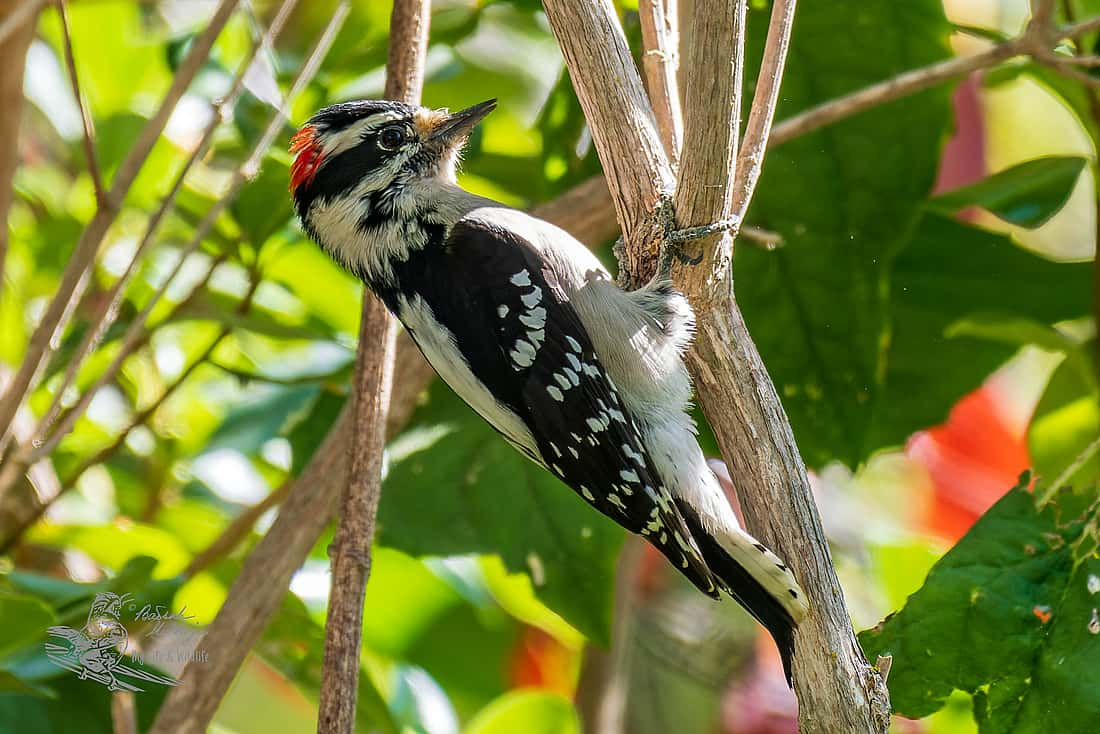
In Closing
If you are lucky enough to have Downy Woodpeckers in your area, watch for them as they are the most common woodpecker to visit home feeders. Their favorite is suet feeders, though they also like mealworms, millet, safflower, black oil sunflower seeds, peanuts, and chunky peanut butter. Along with these you may occasionally see them drinking from hummingbird feeders.
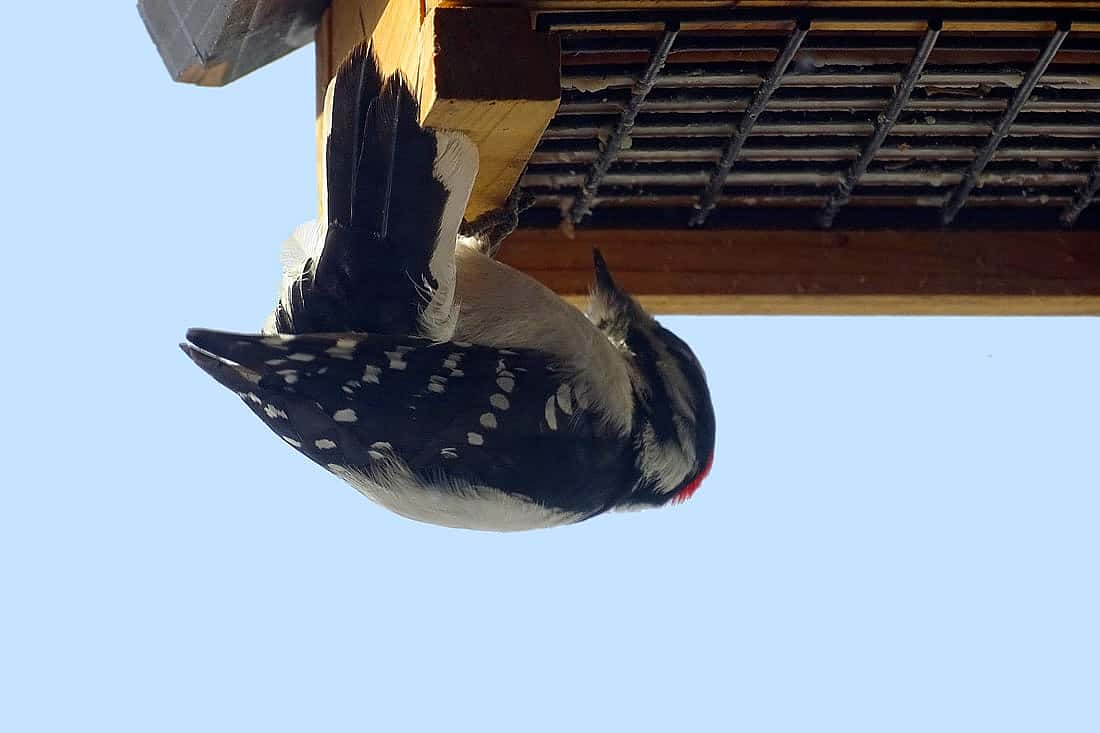
Photos:
Opening photo of a male Downy Woodpecker by Richard Griffin, Attribution-ShareAlike 2.0 Generic License
Downy Woodpecker with Grasshopper by Matt Esberry, Attribution-NoDerivs 2.0 Generic License
Female and Male Downy, by Mark Moschell, Attribution-NonCommercial 2.0 Generic
Male Hairy on tree snag, by Dennis Church, Attribution-NonCommercial-NoDerivs 2.0 Generic license
Female Downy Woodpecker feeding chicks at nest hole by Maureen Leong-Kee, Attribution-ShareAlike 2.0 Generic License (This license gives me permission to transform the photo as long as changes are noted. I sharpened the focus.)
Female Downy Woodpecker with bill full of suet feeding a juvenile male, by Sephen Little, Attribution-NonCommercial 2.0 Generic License
Hairy and Downy Woodpeckers by Paul Hurtado, Attribution-ShareAlike 2.0 Generic License (This license allows users to make changes to the photo as long as if it is noted. I have slightly lightened the photo and sharpened the focus on both birds.)
Hairy Woodpecker with spots on tail by Badsah Mukherji, Attribution-NonCommercial-NoDerivs 2.0 Generic license
Downy Woodpecker at an upside-down suet feeder by author, Anne Hay, Attribution-NoDerivs 2.0 Generic license,
https://www.flickr.com/photos/157982666@N07/
Written By
Anne Hay
Anne Hay has a Bachelor's degree in Elementary Education and a Master's in Computers in Education. She spent most of her working years teaching third grade at Livingston School in Cody, Wyoming. After retiring she began doing a variety of volunteer work for the Buffalo Bill Center of the West’s Draper Natural History Museum. Anne loves nature and has a concern for the environment. She believes that educating the public, so that they will have a better understanding and appreciation for the natural world, is very important. Because of this belief, volunteering at the Center is a perfect fit. She spends time in the Draper Lab, observing eagle nests for Dr. Charles Preston’s long-term research project on nesting golden eagles, writing observation reports of raptor sightings in the Bighorn Basin, and working with the Draper Museum Raptor Experience. Anne states that, “Having a bird on my glove, is one of my all time favorite things in life.”

